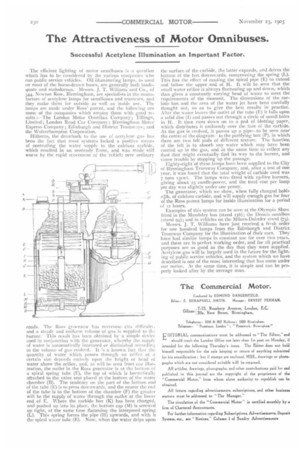The Attractiveness of Motor Omnibuses.
Page 34

If you've noticed an error in this article please click here to report it so we can fix it.
Successful Acetylene Illumination an Important Factor.
The efficient lighting of motor omnibuses is a question which has to be considered by the various companies who run public service vehicles. Oil illuminating lamps, as used on most of the horse-drawn buses, are generally both inadequate and malodorous. Messrs. J. T. Wilimns and Co., of 344, Newton Row, Birmingham, are specialists in the manufacture of acetylene lamps for omnibuses and tramcars, and they make them for outside as well as inside use. The lamps are made under Ross' parent, and the following are some of the companies which employ them with good results :—The London Motor Omnibus Company; 'fillings, Limited; London Road Car Company; Birmingham Motor Express Company; Edinburgh and District Tramways; and the Wolverhampton Corporation.
Hitherto, the drawback to the use of acetylene gas has been the fact that most systems lacked a positive means of controlling the water supply to the calcium carbide, which resulted in an unsteady -flame, and was made still worse by the rapid movement of the vehicle over ordinary roads. The Ross generator has overcome this difficulty. and a steady and uniform volume of gas is supplied to th,2 burner. This result has been obtained lw a simple device used in conjunction with the generator, whereby the supply of water is automatically increased or diminished accordin!.t to the volume of gas evolved. It is a known fact that the quantity of water which passes through an orifice of a certain size depends entirely upon the height or head of water above the orifice, and, as \yin be seen from our illustration, the outlet in the Ross generator is at the bottom of a spiral spring tube (E), the top of which is hermetically attached to the valve seat placed at the bottom of the water chamber (B). The tendency on the part of the bottom end of the tube (E) is to press downwards, and the nearer the end of the tube is to the bottom of the chamber (F) the greater will be the supply of water through the outlet at the lower end of E. Where the carbide box (K) has been charged, and pushed up into its place, the bottom cap (M) is screwed up tight, at the same time flattening the interposed spring (L). This spring forces the pipe (1-1) upwards, and with it the spiral water tube (E). Now, when the water drips upon the surface of the carbide, the latter expands, and drives the bottom of the box downwards, compressing the spring (L). This has the effect of causing the spiral pipe (E) to extend and follow the upper end of H. It will be seen that the small water orifice is always fluctuating up and down, which thus gives a constantly varying head of water to meet the requirements of the moment. The dimensions of the carbide box and the area of the water jet have been carefully thought out, so as to give the best results in practice. After the water leaves the outlet of the tube (E) it falls upon a solid disc (I) and passes out through a circle of small holes in H. It then runs down on to a pad of blotting paper, which distributes it uniformly over the face of the carbide. As the gas is evolved, it passes up a pipe--to be seen near the centre of the diagramto the purifying box (P), in which there are two felt pads of different texture. The function of the felt is to absorb any water which may have been carried up in the gas, and at the same time to collect any dust that might eventually find its way to the burner, and cause trouble by stopping up the passage.
Eighty-eight of these lamps have been supplied to the City of Birmingham Tramway Company, and, after a test of one year, it was found that the total weight of carbide used was 7 tons Iscwt. The lamps were fitted with 15-litre burners, giving about 25 candle-power, and the total cost per lamp per day was slightly under one penny.
The generator, which we show, when fully charged holds 21lb. of calcium carbide, and will supply enough gas for four of the Ross patent lamps for inside illumination for a period of 12 hours.
Examples of this system can be seen at the Olympia Show fitted in the I4laudslay bus (stand 156); the Dennis omnibus (stand 94); and in vehicles on the Milnes-Dainnler stand (73).
Messrs. J. T. Williams have just received, a fresh order for one hundred lamps from the Edinburgh and District Tramway Company for the illumination of their cars. They have had similar lamps in constant use for over two years, and these are in perfect working order, and for all practical purposes arc as good as the day that they were supplied. Acetylene gas will be largely used in the future for the lighting of public service vehicles, and the system which we have described is one of the most interesting that has come under our notice. At the same time, it is simple and can be properly looked_ after by the average man.








































